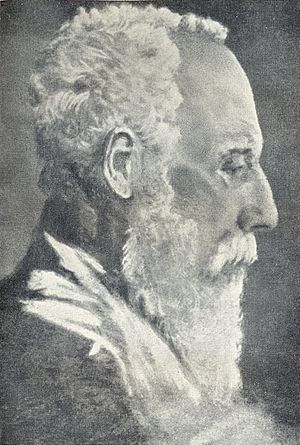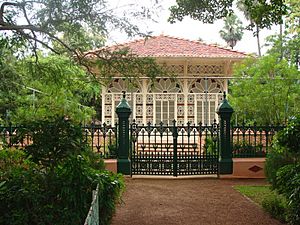Debendranath Tagore facts for kids
Quick facts for kids
Debendranath Thakur
|
|
|---|---|

Portrait of Debendranath Tagore
|
|
| Born | 15 May 1817 |
| Died | 19 January 1905 (aged 87) |
| Nationality | Indian |
| Occupation | Religious reformer |
| Movement | Bengal Renaissance |
| Spouse(s) | Sarada Devi |
| Children | 14, including Dwijendranath Tagore, Satyendranath Tagore, Hemendranath Tagore, Jyotirindranath Tagore, Rabindranath Tagore, Swarnakumari Tagore |
Debendranath Tagore (born May 15, 1817 – died January 19, 1905) was an important Indian thinker and religious leader. He was a key figure in the Brahmo Samaj, a group focused on spiritual and social reform. In 1848, he founded the Brahmo religion, also known as Brahmoism. Debendranath was born in Shilaidaha. His father, Dwarkanath Tagore, was a well-known industrialist. Debendranath had 14 children. Many of them, including the famous poet Rabindranath Tagore who won a Nobel Prize, became very important artists and writers.
Contents
The Tagore Family Home
Debendranath Tagore was born into the famous Tagore family in Jorasanko, a part of North-western Kolkata. Their family home, known as Jorasanko Thakur Bari, is now part of Rabindra Bharati University. The Tagore family has a history of over 300 years. They were one of the most important families in Calcutta. They played a huge role in the Bengal Renaissance. This family produced many people who made big contributions. These areas included business, social and religious changes, literature, art, and music.

Debendranath's Education and Work
Debendranath studied at home from 1823 to 1825. In 1827, he joined the Anglo Hindu College. This college was started by Raja Rammohan Roy. After some time, he began helping with his father's business. He also became very interested in philosophy and religion.
A Spiritual Journey Begins
In 1838, after his grandfather passed away, Debendranath felt a big change inside him. He became deeply interested in religion. He started studying many different subjects. These included the Mahabharata, the Upanishads, and both Eastern and Western philosophy. This led him to seek a deeper spiritual understanding.
Founding the Tattwabodhini Sabha
In 1839, Debendranath started a group called "Tattwaranjani Sabha." This group later changed its name to the Tattwabodhini Sabha. Around this time, he also published a Bengali translation of the Katha Upanishad in 1840.
Leading the Brahmo Samaj
In 1842, Debendranath took charge of both the Tattwabodhini Sabha and the Brahmo Samaj. The next year, he paid for the Tattwabodhini Magazine to be published. Akshay Kumar Datta was its editor. This magazine published the Upanishads with Debendranath's explanations. Debendranath also helped start public meetings about the Vedas.
In 1844, he introduced the first way to worship in the Brahmo Samaj. This method was used from the next year onwards. After much study, he realized that the Brahmo religion could not be based only on the Upanishads. So, from 1848, he began publishing a translation of the Rig Veda. This was in the Tattwabodhini magazine. It was later published as a book called Brahmodharma in 1869. In 1850, another book by him, Atmattvavidya, was published. He became secretary of the Tattwabodhini Sabha in 1853. In 1859, he started the Brahma Vidyalaya.
Social and Religious Reforms
Debendranath stopped traditional Hindu pujas (worship ceremonies). Instead, he introduced new festivals. These included 'Magh Utsav', 'New Year', and 'Diksha Din'. In 1867, he bought land in Birbhum called Bhubandanga. There, he built an ashram. This ashram is now the famous Santiniketan. He also helped start the Bethune Society.
Debendranath was involved in politics for a while. When the British Indian Association was formed in 1851, he became its secretary. He worked hard to remove the chowkidari tax for poor villagers. He also wrote to the British Parliament. He asked for India to have more control over its own affairs.
Debendranath strongly supported widow remarriage. However, he was against child marriage and having more than one wife (polygamy). He also helped a lot in spreading education. In 1867, Radhakanta Dev gave him the title 'Protector of National Religion'. The Brahmo Samaj also called him 'Maharshi' (Great Sage). This was to protect Indian youth from the influence of Christianity.
Books by Debendranath Tagore
- Brahma Dharmo Grantho (1851)
- Atmatatto Bdya (1852)
- Brahma Dharmer Mot O Biswas (1860)
- Kalikata Bramha Samajer Baktrita (1862)
- Gyan O Dharmer Unnati (1893)
- Porolo O Mukti (1895)
See also
 In Spanish: Debendranath Tagore para niños
In Spanish: Debendranath Tagore para niños

